Last year Team Arctic’s Brian Nelson took aim at the inaugural USCC Red Lake I-500 vintage event with the same lazer-like focus that made him a cross-country racing legend in the 1970s.
CLICK HERE for the build-up and recap of last year’s effort.
That remarkable effort netted him and his fleet a one-two finish in the reprised race, with teammate Joey Hallstrom winning and Nelson taking a close second.
Never one to rest on his laurels, Nelson will be back again this year, with two “new” El Tigres that he built during the summer and fall.
Earlier this week I spent a day in his Spicer, Minn., shop, working on my race sled and documenting the master at work, doing what he does best.
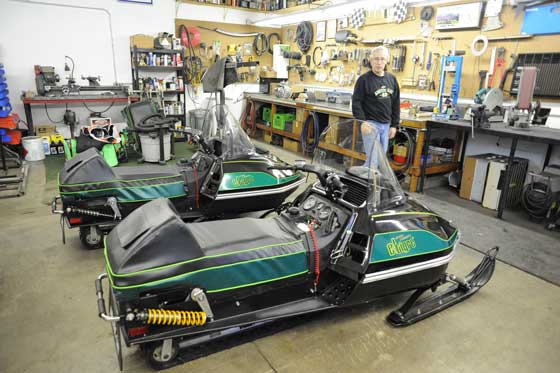
From the “How I Spent My Summer” files come these two 1979 Cross-Country racers that are brand-new for this race season.
Yep, despite the fact that the pair of Tigers that went 1-2 at last year’s race are still perfect and will likely be raced again this year, Nelson built ANOTHER pair of racers for this year’s event, each bearing new tweaks and improvements based on what was learned last season.

While very similar to last year’s sleds, these new machines feature shorter tracks, slightly taller seats and new calibration of the FOX shox.
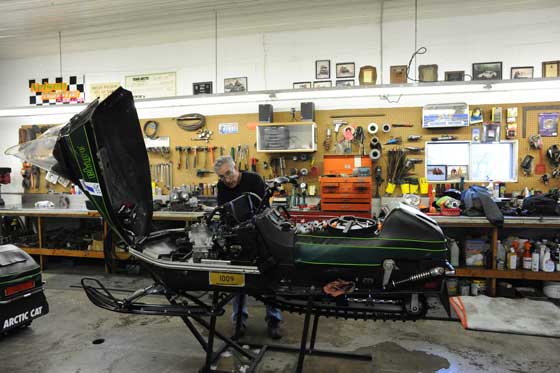
My own race sled was in his shop on this day, ready to get some of that good ol’ Brian-Nelson-Black-Magic. On the agenda: a motor swap back to the mill that burned down in the middle of last year’s race (and that Nelson rebuilt during the summer); a new hood; and a complete evaluation of everything on the sled.
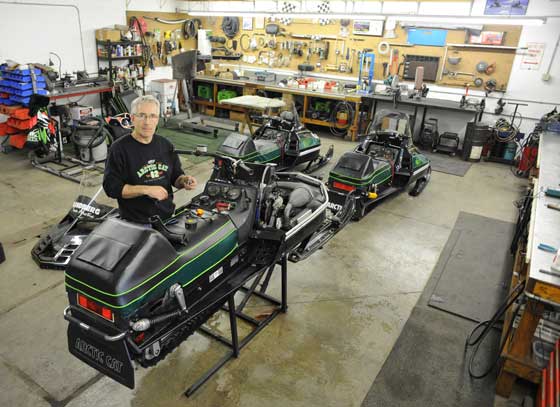
It’s interesting: on my two-hour drive to Spicer that day, driving past fields and ditches that contained just a trace of snow, I was in a sour mood because of this (so-far) lame winter. It’s weird, because I can get amped up to 10 for snowmobiling when it’s 90 degrees in July, but when it’s 40 degrees in January, my mood is decidedly melancholy.
But within minutes of getting inside of this familiar race shop, with the feint smell of metal and combustion, my attitude does a 180.
And as the conversations about racing and riding mix with the rattle of tools and Nelson’s favorite oldies radio station, I am once again fired-up about that winter that will surely come (albeit later than we hoped).

Freshly rebuilt and ready to redeem itself, this 440 liquid engine will power my hopes and dreams this season (and those to come).

Yep, the Spirit’s Gonna Move…me.
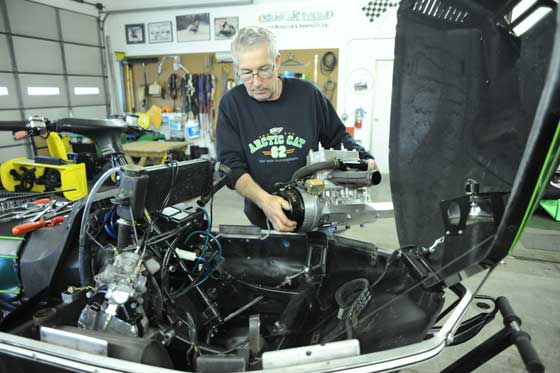
Every time there was a need for heavy lifting, I grabbed the camera. Really, Brian, I think it’s important to capture these images…
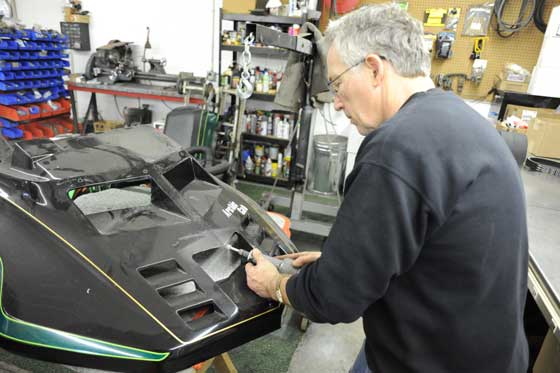
I’m switching to the 1980-81 El Tigre hood for a couple reasons. One, the original hood (which I think looks the coolest) is still in really good condition, and I want to keep it that way. And two, the newer hood has additional venting, which might have been the difference why my engine burned down last year, while Hallstrom’s and Nelson’s didn’t.
This new hood is a repop and the area for the headlight isn’t exact, so it needs a little grinding to make ‘er fit.
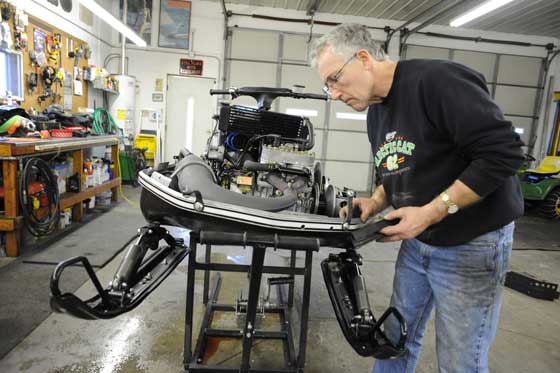
Like a Jedi-master, Nelson notices both the big and small things that need fixing. In this case, the new hood didn’t fit exactly as it should, and was “off” by less than a quarter-inch. While some people might not notice or care, Nelson instantly sees such gremlins, and there’s zero hesitation whether or not to fix them.
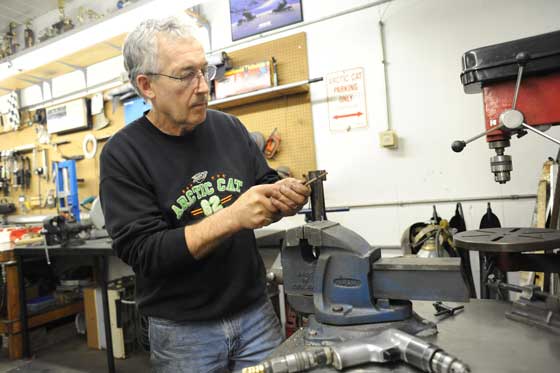
Several trips to the vice with the hood hinge and a rat-tail file are required to fix the problem.
Moments like these literally happen a hundred times with each sled. When we hear of racers “building their race sled,” it can mean “big” efforts like installing an engine, rebuilding shocks or swapping a track. But more often than not, it means these small, fixes that are usually unglamorous and require much trial-and-error. And it’s the accumulation of these efforts that have helped make champions of people like Nelson, Hibbert, Dimmerman, Scheele, Wanderscheid, Pake, Davis, Cormican, Coltom, Ebert, Dick, Herzig, Devault, Young, Hall, Moyle, Yancey, Fyle, Sturgeon and the other Team Arctic legends.
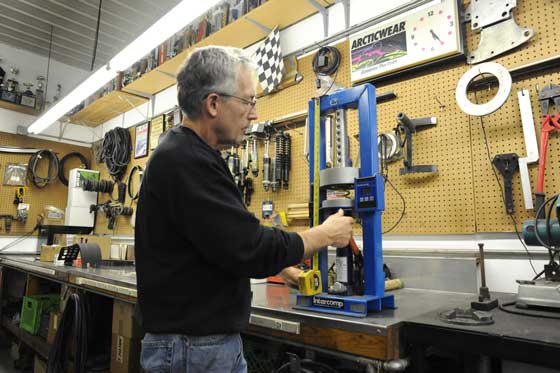
Here’s another example, with Nelson checking the rate of a clutch spring. You can take five orange-colored springs and there will be a small variance between them. A box full of such springs, each marked, can help fine-tune clutch performance that little, extra bit.
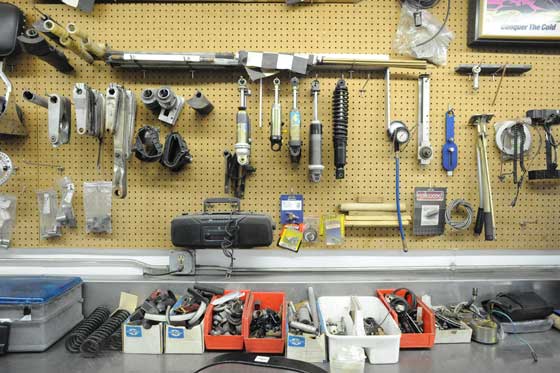
The accumulation and organization of parts and tools is yet another defining characteristic of champion race efforts.
For me personally, having raced out of this shop in 1994 and again last season, the familiarity of such things and their corresponding routine brings a joy and satisfaction that are tough to describe.
There are dozens of such routines for those lucky and persistent enough to work and/or race out of a shop, ranging from the kinds of rags you use (old t-shirts for this shop) to the brand of wash soap (dish soap and Lava) to where you relieve yourself (outside, in the little section of garden between the shop and the garage).

Undoubtedly one of the most familiar aspects to many is their toolbox and the lifetime of tools contained within it.
I love the fluidity of navigating each drawer without even thinking, knowing exactly where each tool rests… where to place the razor blades so that you don’t cut yourself… where the homemade spring tool sits in the screw driver tray… the special spot for the 12-point 13mm socket for the clutch bolt…and a hundred other nuances for your box.
The patina that each tool box takes is equally cool, and it’s no surprise I’m particularly fond of this old Snap-On box and cab that have graced Nelson’s shop for decades.

In the nearly 12 hours we worked on this day in January, we made steady progress.
From checking heating elements in the handlebars to re-torquing skidframe bolts, there is literally no end to what can be done to a race sled.
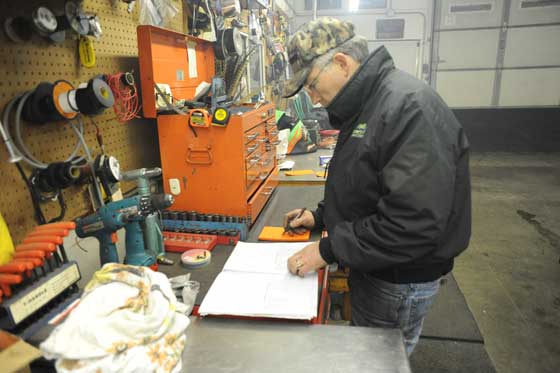
And like he has done hundreds-upon-hundreds of times previously, Nelson ended this day jotting notes of things to do and parts to order.
And so it goes, another day in the life of a champion racer.
Thanks for reading.
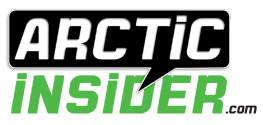


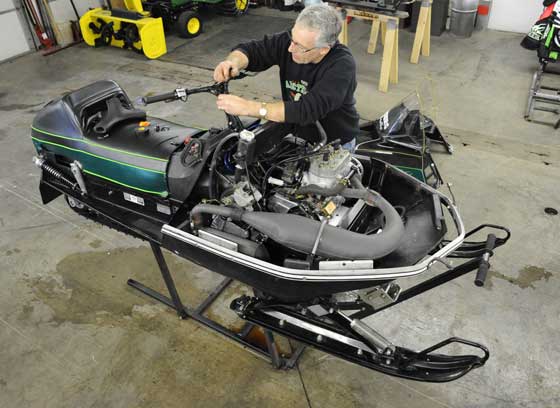
That’s a great looking fleet of race sleds. Thanks for the update John and good luck to you and your teammates!
would like to switch 79 440 hood with my80 500 hood for the i500 the rule book says same year parts could someone clearify this for me , thanks new to cross country tery wagoner 218 750 6566
Another great article John, and good luck!!
Hey JS!
The sleds are lookin’ good! How about some snow now?
Dave
John, when you wrote “shorter tracks” I’m assuming you meant a shorter lug? Looking for more top speed? So, did last years race sleds/your sled, stay equiped with taller lugs? Thanks for sharing this story. GREAT!
John,
FYI you will need Road Runner Wheels(trademark) on your Ski’s. That is what Hallstrom Has used for years to win. Brian is looking lean and mean. I will have to stop by Brian next time in town. I miss the old days!!!
Terry: regarding the hood change, last year Pat Mach gave the go-ahead to switch hoods, based partially on the fact that you can’t get replacement hoods in the old style (you can get repops of the 80-81 hoods), and also because it didn’t really matter to him (Pat).
Like he said at the time, racers can use whatever shocks, skis, seat, etc… that they wanted, so too with the hood.
Todd: Brian and Joey’s sleds last year had 121-in. tracks, which required a TON of time/modification of the skidframe to make work. Too much work, actually. For his new sleds, he went to a 116-in. Camoplast that only required just a little modification of the stock skid rails.
Doug: I’m going to put wheels in the skid and on the skis, then give Joey a run (down the road) for his money!
Great read as always, John. Really like your description of Brian’s shop. There is something just really cool about a shop like that. All the hard work that has gone on in there over the years. Memories of projects that worked out great, and those that didn’t. Spending long hours working with your friends toward a common goal. Pretty neat!
John, as always another great story and photos of Vintage Snowmobile Racing, low 40’s in gods country today, not good for making ice, i hope Pine Lake can go on, I will be there holding a radar gun just like the old days.
Steve
John,
I was told Brian was putting cement in Joey’s Seat foam along with a 56 h.p. kit. The original tracks were Rockland today as we have come to know Camoplast. I’m getting old, but I think they somewhere in between 116″ to 121 “. I think Rocklands where used on Ski-doo’s/ Moto Ski’s back in the day?? Good Luck!!!!
Allow a bit of “pot stirring” please……..Brian’s preparation even in the 70’s was equal only to the likes of Cormican, Hayes, and Lindblad for the I-500, Hubert Fixsen was the cornerstone. My challenge based on historicals is to replicate Brian’s wins and win today on both brands, Cat and the Liquidator! May not be popular on this site, but certainly legendary relative to history and recognition . I know his Cats are works of art, so in deed was his Deere and that victory was the finest cross country driving this writer has ever seen. See you Febuary, next year should be a Deere buddy, such fun we have! Best JRC
John S:
Great read as always. Praying for snow on the new dates, reservations are made for both the Vintage Challenge and the Vintage I-500. Going to be a great week no matter the outcome.
Lots of sleds are being prep’d to try to take the crown this year, and no doubt we will have a bigger turn out for vintage. And you can bet my Liquifire will see gas before it gets to Minnasota this time, LOL!
JRC has a good point, Brian did race a 340/s and a Dator of course. We got Brian on a 340/s for the Vintage Challenge of 2010 after all:>)
Looking forward to seeing all the racers in February!
-Joe Rainville, #621
What an asset Brian continues to be for Arctic Cat. I had the pleasure of driving the coach to Yellowstone and Crooked Creek on several of Brian’s trips for several years. He was great at fixing any sled that had a problem, showed the people great riding and was always pleasant to be around. My favorite memory is of Joey Hallstrom aboard a proto F5 racing a Thundercat 1000 on Elk lake. Joey lost by a sled length and a half but what a great sight.Good Luck to Brian and Joey in the I-500!!
John, as always a great story!!! Looking forward to seeing everyone again at the HOF ride.
DA
Another excellent sorty and pictures…makes up for the long days with a short amount of snow!
This is a cool story . Good luck in your racing guys.
John, update from St.Hiaire MN Vintage Race scheduled for Feb. 4th, has been cancelled for the 2012 season, had a meeting last night and decided to start planning for next year. The river is very deep now and flowing full force, ice only on edges, 85% of our snow went yesterday. With the revised schedules for races and vintage rides up north we have to shoot for next year. I will keep you updated. Had a dream though to keep me up beat, was resting on top of a muskrat house on Pine Lake holding a radar gun with Bubba Ness clocking speeds as the new sleds come out of the weed beds on to the long straights in the howling Ice groove.
Keep writing…..
Steve
Any chance of seeing one of these selds (not the raffel) at the HOF ride?
John would you comment on adding the ZR chaincase to the sleds. I assume, and its a big “assume” that the center to center of the ZR vs the El Tigre would not be the same. Was the drive shaft or the jackshaft location moved.
I am amazed how the 121 passed tech when there was an issue with Polaris dial adjust rears… ie Indy Suspensions in the TXLs.
Ryan,
I will try to help you out here: I am pretty sure the ZR era Cat’s have the same center to center as the mid-70’s Cats, including the Suzuki Fury and Scorp Sidewinder. I am told its not a hard update, but I think you need to use a ZR jackshaft too.
According to the USCC Vintage Rules, you can use any comercial track, it does not have to be stock length. You can also use any commercially available shock or spring, but you cant not modifiy the suspension for more travel, and stock suspension arm are implied by that rule. You can alter the rear wheel set up to fit a 121″ track on a sled that originally came with a 116″. One of the Deere guys did that, and had the late, great, Pat Mach approve the required changes before he did the work.
I hope this helps!
-Joe
PS: I agree, it would be great to see Brian testing these baby’s out at the Vitntage Challenge:>)
I appreciate the quality of these sleds and the great race that went on last year. I am wonderering why a word has not been said about the little yamaha ss (440 fan single carb)?? This sled was quite a ways ahead and only battling with Aaron S. They were a long way ahead when motor issues caused them and many to fall out near warren.
Pretty sure they are talking about that on TotallyYamaha.com.
hey John those sled are awsome. I just bought one on ebay and it needs a track could you give me any help on what you guys did to get the 116 track to fit. Any help would be much appreciated.Thanks
I have a motor with the number being E34-200048 on the case the cylinder measure 59 mm bore. This motor looks like the 440 in the pictures above. I am trying to figure out what this motor comes out of. I believe it to be a 340 l/c suzuki motor with a y pipe exhaust and cooling pump configuration is like that of the el tigre and not the Z sleds from 76 and 77.
Brian; I have a 1981 El Tigre 6000 with 1000 miles on it and 2 new old stock 1978 belly pans if you know anyone that is interested. I kept this sled around as I did chassis design and all of the plastics design when I worked at Arctic. I remember Roger Skime standing on the running boards of one of the first prototypes and saying that it wouldn’t work because the front end flexed. It went 3500 miles in field test and Roger became one of it’s biggest supporters.Gene Hanson did all of the suspension work on the production sled and also took the first prototype for a ‘ride’ an hour after it was finished and totaled it in the bottom of a drainage ditch 1/2 hour later….broke his arm so bad it had to be repaired in Grand Forks. Good luck in the races……
We bought this in a yard sale sereval years ago. We used it for the last four years to pull two children in it from home to daycare on snow days and more recently the children have used it to slide down the road on our cul de sac. Great to drag or to slide down hills. Has withstood all sorts of harshness including some dragging over crossroads roads where the snow had been shoveled. Very sturdy!
Hi Mac,I could hear Aliy just fine. I like the format, eslceiaply if it saves her time and allows her to multitask in these hectic 2 weeks leading up to Iditarod. Can’t wait to see footage from the race. I appreciate your inventiveness in creating the camera rig on the sled and the overall dedication everyone up there has for bringing us superior coverage. http://krzmiczeqp.com [url=http://mhlrdbw.com]mhlrdbw[/url] [link=http://jcipvpf.com]jcipvpf[/link]
Great video as always! I noetcid that the dogs were able to multi-task very well by reaching down to scoop snow while running. How often do they do this? I’ve never noetcid it during the races, but of course most in most of the other videos, they have seen the videographer. Now I am very curious! http://edlqlrcw.com [url=http://hflifxn.com]hflifxn[/url] [link=http://xwouxzmcnxg.com]xwouxzmcnxg[/link]